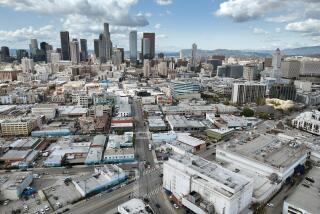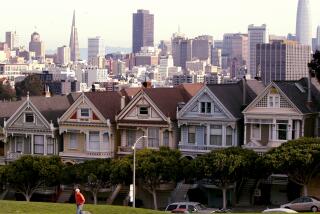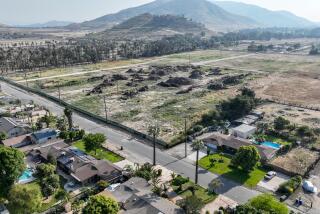Southeastern San Diego could get a boost in redevelopment
Efforts to bring southeastern San Diego better jobs, more places to shop and new housing could get a boost Monday when the San Diego City Council is scheduled to approve the area’s first comprehensive set of zoning changes since 1987.
The goal of the changes is helping southeastern San Diego shed its reputation for poverty and crime by encouraging more development, particularly projects along transit corridors featuring housing and commercial space.
Community leaders often complain that the area’s lack of high-paying jobs discourages developers from building quality retail and housing projects, even though much of southeastern San Diego is less than 10 minutes from downtown.
City Councilwoman Myrtle Cole, whose district includes much of the area, praised the changes when the council gave them preliminary approval last month.
“This new plan is a step in the right direction and a guide to what we all want to see and encourage: quality retail, balanced mixed-income housing, pedestrian-friendly infrastructure, additional parks and open space and quality employment opportunities,” she said. “We don’t want to continue on the same path we’ve been on since 1987.”
Cole and Mayor Kevin Faulconer took several dozen developers on a tour of the area last February hoping to spur interest. Many on the tour said updated zoning would play a key role in whether they pursue projects.
City officials, who spent 31 months analyzing the area and held dozens of community meetings, have decided to split it into two parts — southeastern San Diego west of the 805 Freeway and Encanto east of the freeway — and to adopt separate community plans for each.
A community plan is a blueprint for future growth that specifies what kind of projects should be built and where they should be located. San Diego is updating such plans in many neighborhoods across the city, with new plans adopted recently for Grantville and Ocean Beach.
The southeastern San Diego and Encanto plans cover a large area bordered by California 94 to the north, the 5 Freeway to the west, National City to the south and Lemon Grove, Skyline and Paradise Hills to the east.
The changes aim to spur development by rezoning 6,740 acres in the area, where there is more vacant and underutilized land than anywhere else in the city. But even the strongest supporters acknowledge it may take 20 to 30 years for many of the goals in the two community plans to be met.
“It’s certainly not going to come overnight,” said Councilman David Alvarez, who represents part of the area. “But it’s a long-term project.”
Alvarez said community leaders must lobby for the money needed to build some infrastructure projects planned for the area. He said primary options should be federal money called community development block grants and Transnet, the county’s half-cent sales tax surcharge that funds transportation projects.
Many of the projects envisioned by the new zoning would require developers to fix flooding problems or widen streets, which could discourage them from moving forward.
Although it’s relatively low-income, southeastern San Diego has about $1 billion in unmet consumer demand because the area lacks sufficient stores and restaurants to serve its residents, who must do much of their shopping elsewhere, studies show.
The plans have received strong support from community leaders, but some have complained they would bring too much additional housing, particularly low-income housing.
The number of multifamily housing units — apartments and condos — would triple from 4,000 to 12,000 in Encanto and increase 37% in southeastern San Diego, from 9,400 to 12,900. Meanwhile, the number of single-family homes would stay about the same in each area.
Lara Gates, the city planner overseeing the new community plans, said it’s important to note that the new housing units won’t be in residential neighborhoods, which the plan essentially leaves alone.
The new housing is restricted to targeted areas along trolley lines and in high-potential commercial spots such as Euclid Avenue, Market Street, Imperial Avenue and Commercial Street.
That fits with “smart growth,” a governing concept in San Diego planning since the “city of villages” idea was introduced nearly two decades ago. The goal is avoiding sprawl by increasing density along existing transportation corridors.
Commercial Street, however, spurred some dissension during the process of creating the plans, with city officials recommending light-industrial zoning between 28th and 32nd streets and merchants lobbying for mixed-use, which includes commercial and residential.
The version the council will consider Monday sides with the merchants by replacing 150,000 square feet of light-industrial zoning with mixed-use, which will allow 600 additional residential units on that part of Commercial Street.
Steve Veach, a member of the Southeastern San Diego Community Planning Group, said despite disagreements about details, the updates are clearly steps in the right direction.
“It protects our historic communities while bringing the plan into this century,” he said.
Garrick writes for the San Diego Union-Tribune.
ALSO
San Bernardino County offices reopen, but health workers get more time to recover
Compton woman charged with attempted murder after abandoned baby is found in crevice
Paris-bound flight diverted to Canada because of ‘anonymous threat’
More to Read
Sign up for Essential California
The most important California stories and recommendations in your inbox every morning.
You may occasionally receive promotional content from the Los Angeles Times.










